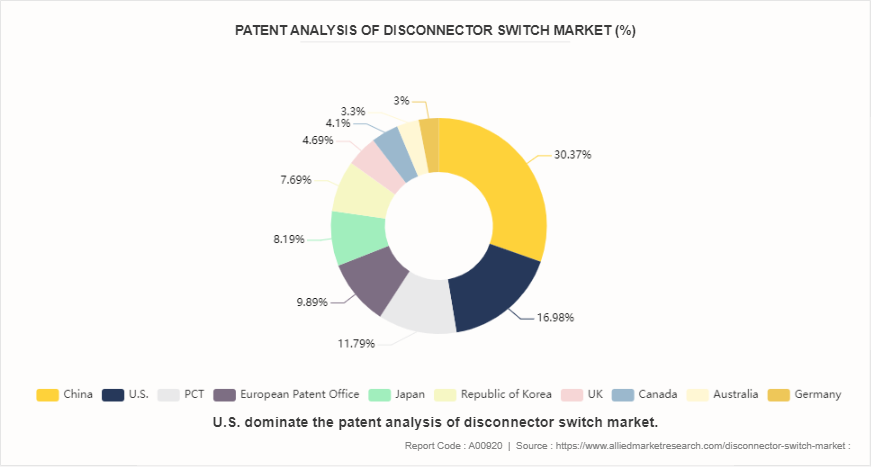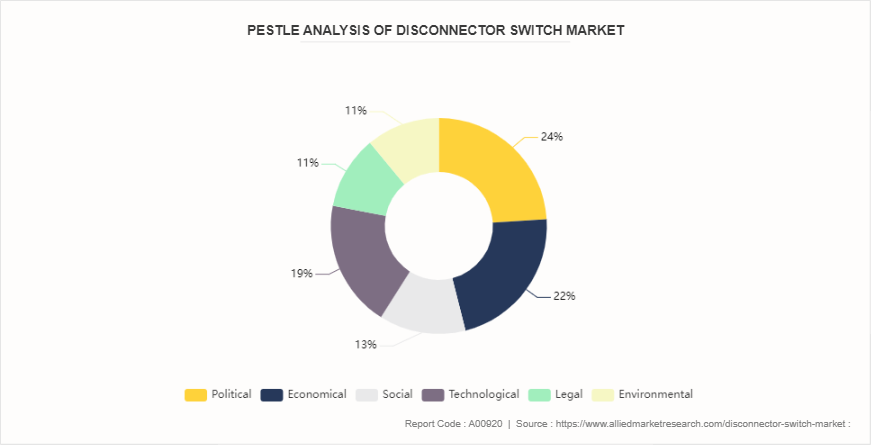Disconnector Switch Market Research, 2033
The global disconnector switch market was valued at $14.8 billion in 2023, and is projected to reach $24.3 billion by 2033, growing at a CAGR of 5.1% from 2024 to 2033.

Market Introduction and Definition
The disconnector switch market refers to the global industry involved in design, manufacture, distribution, and sale of disconnector switches, also known as isolators. Disconnector switches are crucial electrical safety devices used to physically separate electrical circuits from power sources, ensuring safe maintenance and operation of electrical systems. These switches play a vital role in power generation, transmission, and distribution networks, as well as in industrial, commercial, and residential applications. The market encompasses a range of products varying in voltage ratings, insulation types, and designs to meet diverse electrical system requirements. As an integral component of electrical infrastructure, the disconnector switch market is influenced by factors such as energy demand growth, power grid expansions, renewable energy integration, and technological advancements in electrical systems. The market's scope includes both traditional mechanical disconnectors and modern motorized or remote-controlled variants, catering to the evolving needs of the electrical industry for improved safety, reliability, and efficiency in power management.
In industrial application, disconnector switches are crucial for the safe operation and maintenance of electrical equipment. Industries such as manufacturing, oil and gas, chemical processing, and mining rely heavily on complex electrical systems to power machinery and equipment. In these environments, disconnector switches are used to isolate motors, transformers, or entire production lines during routine maintenance, repairs, or in emergency shutdowns. For example, in a manufacturing plant, a disconnector switch might be used to isolate a conveyor system or a large motor, ensuring that maintenance personnel can work safely.
Key Takeaways
- The disconnector switch market study covers 20 countries. The research includes a segment analysis of each country in terms of value for the projected period.
- More than 1,850 product literatures, industry releases, annual reports, and other such documents of major disconnector switch industry participants along with authentic industry journals, trade associations' releases, and government websites have been reviewed for generating high-value industry insights.
- The study integrated high-quality data, professional opinions and analysis, and critical independent perspectives. The research approach is intended to provide a balanced view of global markets and to assist stakeholders in making educated decisions in order to achieve their most ambitious growth objectives.
Market Segmentation
The disconnector switch market is segmented into type, mount, voltage, application, and region. Based on type, the market is divided into fused and non-fused. As per mount, it is divided into panel, din rail, and others. Based on voltage, it is divided into low, medium and high. On the basis of application, it is divided into industrial, residential, and commercial. and Region-wise, the market is analyzed across North America, Europe, Asia-Pacific, and LAMEA.
Key Market Dynamics
Several factors contribute to the global disconnector switch market's robust expansion. Also, one of the main drivers is the growing need for electricity worldwide, especially in emerging economies that are quickly industrializing and urbanizing. To sustain their economic growth and fulfill their growing energy needs, these regions are making significant investments in the infrastructure necessary for power transmission and distribution. Furthermore, the increasing integration of renewable energy sources into current grids necessitates the use of sophisticated disconnector switches that can manage bidirectional power flows. This demand is further increased by the move to smart grid technologies, that require disconnector switches with remote control and monitoring features to improve the dependability and efficiency of the grid. But the market has a lot of obstacles to overcome. large-voltage disconnector switches have large capital expenditures that can be unaffordable, especially for smaller utilities or cost-sensitive markets. Adoption of disconnector switches is further hampered by the technical difficulties in maintaining and installing these switches.
Furthermore, the long operating lifespan of current disconnector switches lowers the need for replacements, which could impede market expansion. Due to mounting environmental concerns and regulatory pressure, there is a growing demand for environmentally suitable substitutes for SF6 gas-insulated switches. Industry 4.0 and the Internet of Things (IoT) have created new opportunities for linked, smart disconnector switches that provide improved operational efficiency and predictive maintenance. By offering real-time data and diagnostics, these sophisticated switches help enhance grid management and minimize downtime. In addition, the need for more advanced disconnector switch solutions is being driven by the growing emphasis on grid resilience and reliability. To ensure a consistent and dependable power supply, utilities are searching for sturdy and secure disconnector switches due to the increasing risks associated with cybersecurity and the effects of extreme weather occurrences. New application areas for disconnector switches are also presented by the growth of microgrid systems, which are localized grids that are self-sufficient. Furthermore, there is rise in need for dependable and effective power distribution systems as a result of the electrification of transportation, which includes electric cars and the infrastructure necessary for charging them.
Competitive Landscape
The major players operating in the disconnector switch market include ABB Ltd, Siemens AG, Schneider Electric, Eaton Corporation, General Electric, Crompton Greaves Ltd, Havells India Ltd, Hubbell Power Systems, Mitsubishi Electric Corporation and Lovato Electric S.p.A. Other players in disconnector switch market includes Larsen & Toubro (L&T) , Rockwell Automation, and so on.
Regional Market Outlook
The disconnector switch market's regional forecast shows that various regions are seeing different growth trajectories. Significant market expansion is being driven in the Asia-Pacific region by rapid industrialization, urbanization, and large investments in electricity infrastructure, especially in nations like China and India. Developments in smart grid technology and the growing integration of renewable energy sources are driving up demand for disconnector switches that can manage remote operation and bidirectional power flow. North America's economy is growing steadily thanks to initiatives to update its system, replace deteriorating infrastructure, and prioritize cutting-edge power distribution technologies. Market growth is helped by technical advancements like smart grids and the Internet of Things as well as regulatory requirements. Growth in Europe is fueled by initiatives to update the electrical grid and follow tight environmental and safety regulations.

Industry Trends
- In October 2023, Littelfuse, Inc., a leading industrial technology company focused on advancing sustainability, connectivity, and safety, introduced its Class J Fuse Disconnect Switch. This innovative, compact device integrates a switch with multiple fuses, providing a streamlined solution for manually opening and closing circuits while ensuring protection against overcurrent and short circuits.
- In November 2020, Littelfuse introduced its DC Disconnect Switch product line, the LS6 and LS6R series, which are energy-efficient, compact disconnect switches. They offer 250 and 400 amperage ratings, reducing installation and maintenance time, and meet UL 98B, UL 94, and IEC 60947-3 standards.
- In January 2020, French manufacturer, Mersen, expanded its range of fuses and equipment for photovoltaic systems with 1500 V DC/800 V AC inverters. The new product includes NH fuses and horizontal and vertical fuse switch-disconnectors, designed to protect, isolate, and switch the circuit at 800 V AC. Mersen is the only manufacturer offering this complete set.
- In June 2023, Schneider Electric released a new version of its VisiPacT heavy duty safety switch, designed for long-term durability and improved safety and productivity. The switch is designed to meet NEMA KS-1 life test requirements and is tested to IP20 standards for optimal performance. The VisiPacT heavy duty safety switch is expected to be available at the NFPA Expo.
- In October 2023, Littelfuse, Inc. launched its Class J Fuse Disconnect Switch, a compact device that combines a switch and multiple fuses into a single product. The 600 V switch is available in 30-60, 100, and 200 A and protects various industries, including HVAC/R, mining, solar, energy storage, and industrial. It features a small footprint, no-tools-required frontal direct handle, safe-to-touch transparent fuse covers, and optional handles.

PESTLE Analysis
Political factors significantly influence the disconnector switch market, as government policies on energy infrastructure, renewable energy adoption, and electrical grid modernization directly impact demand. Regulations on safety standards and environmental protection also shape product specifications and market trends. Economic factors play a crucial role, with overall economic growth driving industrial expansion and consequently the need for power infrastructure. Investment in power generation and transmission projects, both public and private, directly correlates with market growth.
Fluctuations in raw material prices, particularly metals used in switch manufacturing, affect production costs and pricing strategies. Social factors, while less direct, still impact the market through increasing awareness of energy efficiency and safety in electrical systems, influencing both industrial and residential demand for high-quality disconnector switches. Technological advancements are reshaping the market, with innovations in switch design improving reliability, efficiency, and remote operation capabilities. The trend towards smart grids and digital substations is driving demand for more sophisticated disconnector switches with enhanced monitoring and control features. Legal factors are closely tied to political ones, with compliance to international and national electrical safety standards being paramount. Intellectual property rights and patent regulations also influence market dynamics and innovation strategies. Environmental considerations are becoming increasingly important, with a focus on developing eco-friendly materials and designs that minimize environmental impact. The growing emphasis on renewable energy sources is creating new opportunities and challenges for disconnector switch manufacturers, as these systems often require specialized switching solutions.
Key Sources Referred
- IEE
- International Energy Agency
- GovTribe
- Occupational Safety and Health Administration
Key Benefits For Stakeholders
- This report provides a quantitative analysis of the market segments, current trends, estimations, and dynamics of the disconnector switch market analysis from 2024 to 2033 to identify the prevailing disconnector switch market opportunities.
- The market research is offered along with information related to key drivers, restraints, and opportunities.
- Porter's five forces analysis highlights the potency of buyers and suppliers to enable stakeholders make profit-oriented business decisions and strengthen their supplier-buyer network.
- In-depth analysis of the disconnector switch market segmentation assists to determine the prevailing market opportunities.
- Major countries in each region are mapped according to their revenue contribution to the global market.
- Market player positioning facilitates benchmarking and provides a clear understanding of the present position of the market players.
- The report includes the analysis of the regional as well as global disconnector switch market trends, key players, market segments, application areas, and market growth strategies.
Disconnector Switch Market Report Highlights
| Aspects | Details |
| Market Size By 2033 | USD 24.3 Billion |
| Growth Rate | CAGR of 5.1% |
| Forecast period | 2024 - 2033 |
| Report Pages | 300 |
| By Type |
|
| By Mount |
|
| By Voltage |
|
| By Application |
|
| By Region |
|
| Key Market Players | ABB Ltd, Eaton Corporation, Schneider Electric, General Electric, Hubbell Power Systems, Inc., Larsen & Toubro (L&T), Mitsubishi Electric Corporation, Lovato Electric S.p.A., Crompton Greaves Ltd, Havells India Ltd |
The major players operating in the disconnector switch market include ABB Ltd, Siemens AG, Schneider Electric, Eaton Corporation, General Electric, Crompton Greaves Ltd, Havells India Ltd, Hubbell Power Systems, Mitsubishi Electric Corporation and Lovato Electric S.p.A. Other players in disconnector switch market includes Larsen & Toubro (L&T), Rockwell Automation, and so on.
The global disconnector switch market was valued at $14.8 billion in 2023, and is projected to reach $24.3 billion by 2033, growing at a CAGR of 5.1% from 2024 to 2033.
Asia-Pacific is the largest regional market for disconnector switch.
Industrial is the leading application of disconnector switch market
Growing need for electricity worldwide are the upcoming trends of disconnector switch market.
Loading Table Of Content...



